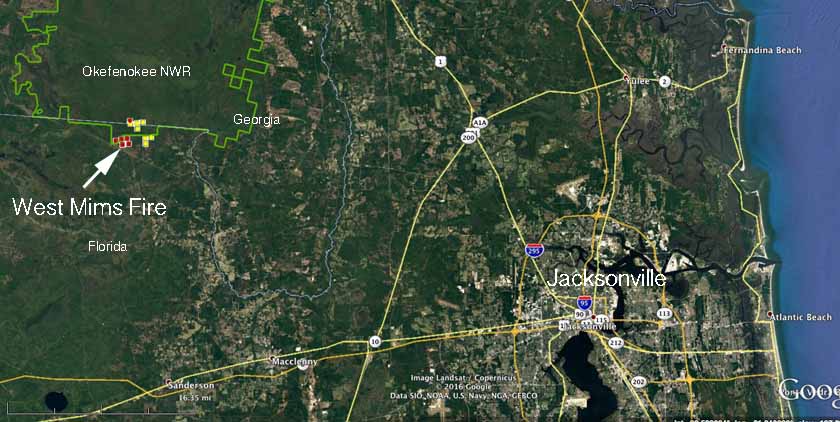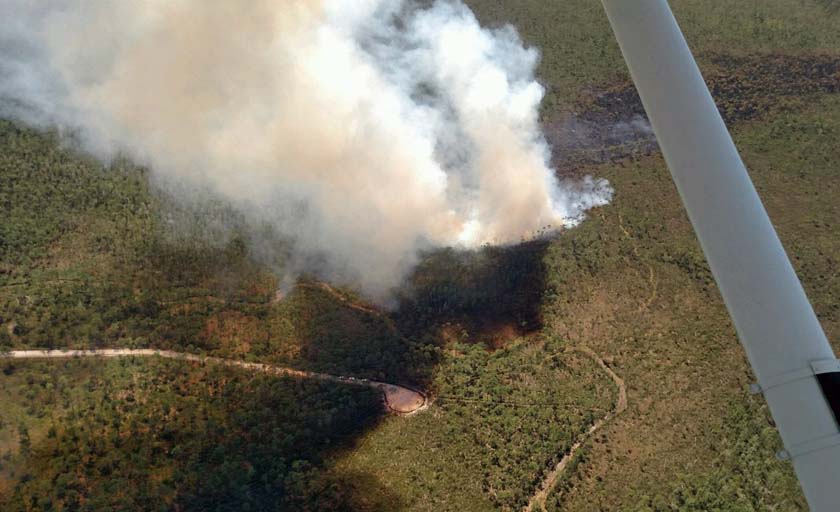Above: A helicopter carries a bucket of water on a drop at the fire in the Okefenokee National Wildlife Refuge. Photo via InciWeb, posted May 14, 2017.
Remember the West Mims Fire?
The massive blaze that generated national media attention for days, threatened a Georgia town and sent ash falling over densely populated cities has all-but-faded away for most of the country. Aided by Mother Nature, crews continue to gain the upper hand on the 152,000-acre lightning-sparked wildfire, which was 60 percent contained as of this weekend.
Seven helicopters, two air tankers, 135 wildland fire engines, 62 bulldozers, five hand crews, and 1,025 personnel were assigned to the blaze Sunday.
“The fire remained relatively inactive,” officials said in an update.
While “inactive” is the name of the game for the West Mims Fire — and for spring fire situations across much of the U.S. inundated with spring storms and abundant moisture — it’s anything but quiet in the Sunshine State.
Twenty-eight fires in excess of 100 acres burned over the weekend within Florida Fire Service jurisdiction, charring 36,000 acres, according to state figures.
Such blazes blackened 109,415 acres of land so far this year.
While we're dealing with snowy #cowx, our crew at the #WestMimsFire in Georgia is seeing smokenadoes. Or, more accurately – smoke whirls. pic.twitter.com/1NBJuW1gDZ
— WestMetroFire (@WestMetroFire) May 18, 2017
Fire danger indices were “high” or “very high” in more than a dozen Florida counties this weekend. Citrus growers “are irrigating daily to keep moisture on the trees,” the USDA reported, and “ditches and canals are very dry in all [citrus] areas.” Plus, livestock producers are having to have hay shipped in as a result of the dry conditions.
And even though some rain was in the forecast for some Florida residents, state officials said they’re not out of danger by any stretch of the imagination.
“We are buckled up for a very long and very hot wildfire season,” said Adam Putnam, the commissioner of agriculture in Florida, according to Bloomberg News.

Meanwhile, others around the country are enjoying a relatively unusual drought-free reality as June nears.
Feet — yes, feet — of snow fell in Colorado and across the Rocky Mountains late last week as a potent spring storm plowed through the region. And places accustomed to persistent drought, like California, continue to bask in aftermath of an especially soggy winter.
18 to 36 inches of snow has fallen in the foothills with this spring storm. An additional 6" to 12" is expected by morning. #cowx pic.twitter.com/R9hAGJCE6s
— NWS Boulder (@NWSBoulder) May 19, 2017
“An active weather pattern continued to result in widespread showers, with some of the heaviest rain falling across the Plains, Midwest, and mid-South,” the U.S. Drought Monitor reported last week.
“Another area of significant precipitation stretched across the middle and northern Atlantic States, while showers also dotted the Northwest. In contrast, mostly dry weather prevailed from California to the lower Rio Grande Valley, as well as large sections of the lower Southeast.”

Though hot temperatures are forecast for parts of California early this week, a cold front is expected to move through the Pacific Northwest, bringing cooler conditions and more moisture, according to the National Weather Service.
Floridians in the meantime will have to keep waiting for the rainy seasons to finally begin, later this month and into June.
“It’s kind of like an ugly cycle. Hot breeds dry and dry breeds hot,” meteorologist Grant Gilmore told the Tampa Bay Times last week. “…It doesn’t look like the cycle breaks in a big way any time soon.”





